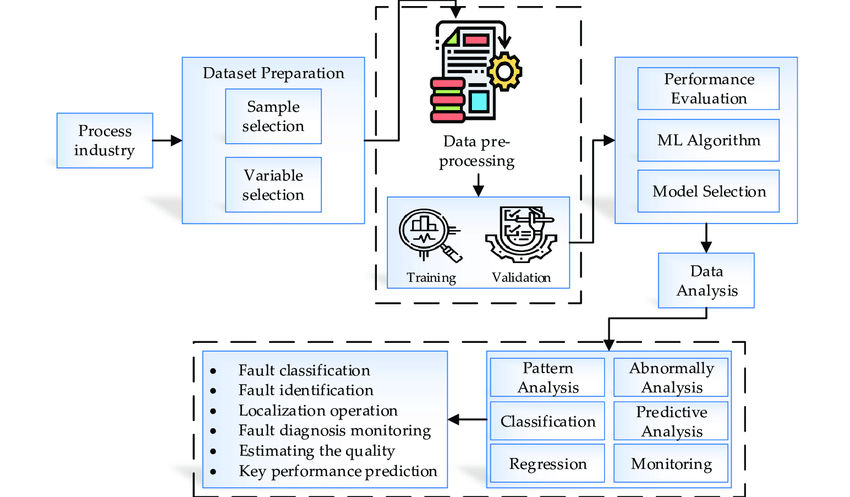
The subject of machine condition monitoring and fault diagnosis as a part of system maintenance has gained a lot of interest due to the potential benefits to be learned from reduced maintenance budgets, enhanced productivity and improved machine availability. Artificial intelligence (AI) is a successful method of machine condition monitoring and fault diagnosis since these techniques are used as tools for routine maintenance.
In the current commercial production industries, there is an increasing trend towards the need for higher availability equipment that can work nonstop 24/7. Thus, any type of failure, even minor, cannot be accepted as it can significantly affect the cost and the production. Hence, a very accurate monitoring of the machine condition and a proper fault diagnosis of the machine failure is necessary.
A majority of Fault Detection & Diagnosis (FDD) available in the market today is rule-based and straightforward to implement. Rule-based FDD specifies expected conditions for equipments with clear limits or ranges of performance. However, rule-based FDD has several disadvantages:
- Increased number of false alarms owing to poorly conceived rules.
- Lack of adaptability as equipments and patterns change over time.
- Poor scope of proactive management during equipment faults or downtime.

Fault detection using machine learning (ML) algorithms overcomes these challenges through analysis of real-time and historical data. ML-driven analytics proactively identifies the issues and allows you to take action before occupants complain, equipment fails, or energy is wasted. Organizations who invest in fault detection using machine learning see lower costs while prolonging the life of the equipment and improving productivity.
Benefits AI-Driven Fault Detection & Diagnosis
FDD should identify problems, notify operators, and recommend solutions when equipment is operating outside of expected performance criteria. AI-driven Methods can do this in a robust and reliable way. Such capabilities mean machine learning should lie at the core of your MES which allows you to integrate maintenance and automation in a holistic way. Some the benefits of using this approach in FDD analytics are as follows.
Limiting False Alarms
The limited analytic capabilities of traditional FDD systems often fail to identify the malfunctioning of a single component in a complex manufacturing process and instead triggers multiple false alarms. Unprioritized and false alarms delay identification of the actual point of failure. Machine learning prevents this by aggregating real-time and historical data to provide context to alarms and suggest effective solutions.
A smart solution using machine learning for fault detection can produce automated response actions to limit nuisance alarms. Managers minimize reliance on human labor to identify the root cause of alarms, and maintenance visits are more focused and cost-effective. Limiting false alarms also prevents premature upgrades or replacement of related equipment, eliminating unnecessary labor and material expenses.
Predictive Maintenance
Effective predictive maintenance of sophisticated systems is a major challenge without smart analytics. Conventional rule-based strategies in fault detection models do not provide enough opportunities for predictive maintenance, resulting in increased downtime and energy wastage. Fault detection using machine learning, however, flags any deviations from historic trends and predicts equipment failures long before they occur. This means maintenance is guided by objective data, not arbitrary schedules and opinions, and optimal performance is easier to maintain.
In conventional systems, there isn’t a lot of validation of predictive maintenance. During a scheduled maintenance visit, the crew quickly inspects the equipment and moves on if there are no obvious problems. Not only does this waste resources on unnecessary visits, it’s also a highly unreliable way to detect and prevent malfunctions. With ML-based maintenance, crews are informed of specific issues and equipment that need to be checked proactively.
Improving Energy Efficiency
There are many sources of energy consumption in a manufacturing facility that directly impact the cost of operations. Fault detection using machine learning identifies the variables in energy consumption patterns, detects anomalies, and provides detailed insights about suboptimal equipment performance. As a result, your ability to optimize efficiency and reduce energy consumption is dramatically expanded.
Creating Smart Production Facilities

Deep Tech offers scalable state-of-the-art FDD solutions for your specific needs. We offer dedicated strategies to limit the number of false positives and false alarms, including analyzing minimum duration and threshold. But it also goes beyond that.
Deep Tech Solution analyzes data points and filters out small deviations to ensure data integrity. It also applies ML-based analytics to various data points and creates a model of behavior for every piece of equipment installed in your manufacturing plants. This provides powerful predictive capabilities and allows you to isolate the cause of problems even in complex systems of equipment, sensors, and devices.
Fault detection using machine learning simplifies maintenance, makes maintenance visits more valuable, and reduces immediate and long-term costs. The result is a more efficient operation and production reliability.
